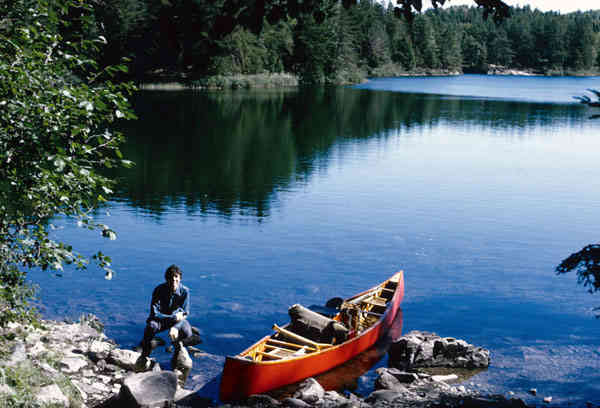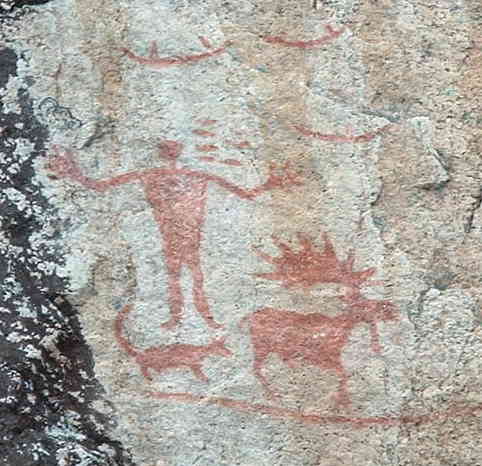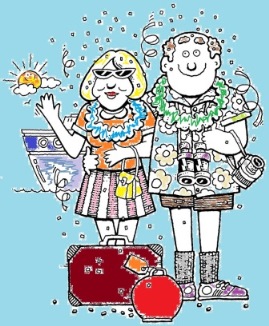Read about Boundary Waters Canoe Area, a great place to go camping. Take the quiz. Know before you go.
Boundary Waters Canoe Area Wilderness(BWCA) attracts many Visitors
The Boundary Waters Canoe Area Wilderness (BWCAW or BWCA), is a 1,090,000-acre wilderness area within the Superior National Forest in northeastern part of a state in the USA. It is under the administration of the U.S. Forest Service. The BWCAW is renowned as a destination for both canoeing and fishing on its many lakes and is the most visited wilderness in the United States.
The BWCAW is located on the U.S.–Canadian border in the Arrowhead Region of the state. Along with Voyageurs National Park to the west and the Canadian Quetico and La Verendrye Provincial Parks to the north, they make up a large area of contiguous wilderness lakes and forests called the “Quetico-Superior country”, or simply the Boundary Waters. Lake Superior lies to the east of the Boundary Waters.

BWCA and wood-and-canvas canoe. Photo by User: Motorrad-67.
Vegetation
Boundary Waters has lakes and boreal forest (taiga) and a mixed conifer-hardwood forest known as the North Woods. The ranges of the plants and animals continue north into southern Canada and south into the rest of the upper Great Lakes region. Trees found within the wilderness area include conifers such as red pine, eastern white pine, jack pine, balsam fir, white spruce, black spruce, and white-cedar, as well as deciduous birch, aspen, ash, and maple. Blueberries are common in many parts of the BWCAW, as are raspberries.
There have been several fires in the wilderness over the years. The Pagami Creek Fire, sparked by lightning in August 2011, ultimately grew to over 92,000 acres, spreading beyond the wildnerness boundary to threaten homes and businesses. Smoke from the Pagami Creek Fire drifted east and south as far as the Upper Peninsula of Michigan, Ontario, Chicago, Poland, Ukraine, and Russia.
Animals
The Boundary Waters is within the range of the largest population of wolves in the contiguous United States, as well as an unknown number of Canada lynx. Animals native to the region include moose, beaver, wolves, bears, bobcats, bald eagles, peregrine falcons and loons.
Woodland caribou once inhabited the region but have disappeared due to loss of habitat, encroachment by deer, and the brainworm parasite carried by deer which is harmful to caribou and moose populations. Increasing deer numbers may also affect the future of vegetation in this region as they favor some species over others, such as white-cedar.

Pictographs at Hegman Lake, as they looked in 2003. Photo by Etphonehome, SA-CC-by-3.0
Native Americans
Within the BWCAW are hundreds of prehistoric pictographs and petroglyphs on rock ledges and cliffs. The BWCAW is part of the historic homeland of the Ojibwe people, who traveled the waterways in canoes made of birch bark. Prior to Ojibwe settlement, the area was sparsely populated by the Sioux who dispersed westward following the arrival of the Ojibwe. The Grand Portage Indian Reservation, just east of the BWCAW at the community of Grand Portage, is home to a number of Ojibwe to this day.
Recreation
The BWCAW contains over a thousand lakes and attracts visitors with its reputation for canoeing, canoe touring, fishing, backpacking, dog sledding, and remote wilderness character. The BWCAW has nearly 2,200 backcountry campsites. The BWCAW is one of the state’s top tourist attractions, drawing visitors from all over the United States as well as abroad. Permits are required for all overnight visits to the wilderness area. Quota permits are required for groups taking an overnight paddle, motor, or hiking trip, or a motorized day-use trip into the BWCAW from May 1st through September 30th. Be sure to check beforehand for times, dates, and permit information before you visit this great area.
Visitor Information
The two main communities with visitor services near the BWCAW are Ely and Grand Marais. The smaller town of Tofte is another gateway community. Several historic roads, such as the Gunflint Trail, the Echo Trail, and Fernberg Road allow access to the many wilderness entry points.

Info coming soon, similar to ToyWish Offer, but requires less $$. If interested, Contact me HERE. Mention BarePaw Offer.
View pictures and read the article above BEFORE you take the quiz.
Let’s see how good you are on this quiz on Boundary Waters Canoe Area Wilderness.
Answer all questions. Each answer is worth about 10 points. If you don’t know the answer, then take a guess (unless you want a guaranteed zero for the answer). This test is timed (3 min) so be aware of that. Boundary Waters Canoe Area Wilderness (BWCA) is definitely a place you might want to visit if you like camping, hiking, canoeing, and wilderness areas To learn more about USA wilderness areas click the link indicated below.
Quiz #17 Boundary Waters Canoe Area Wilderness
 This Travel Quiz is about Boundary Waters Canoe Area Wilderness (BWCA). Some questions have clues while others may not. This quiz also has True/False answers. The level of this test is easy.
This Travel Quiz is about Boundary Waters Canoe Area Wilderness (BWCA). Some questions have clues while others may not. This quiz also has True/False answers. The level of this test is easy.











